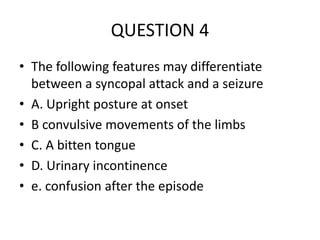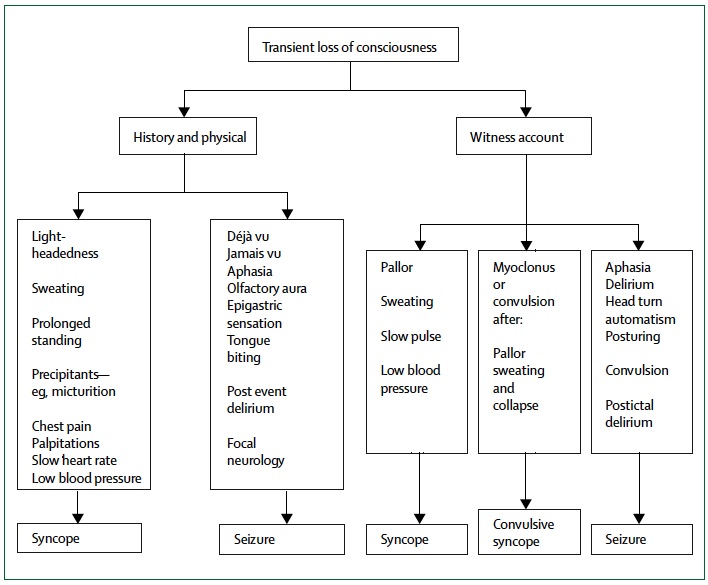

10 These signs might be very difficult to distinguish from seizure disorders not only for the layman. Multifocal jerks sometimes superimposed on generalised myoclonus seem most common, 9, 10 but other features have also been reported such as eye movements and vocalisations, as well as tonic spasms 7– 9 or righting movements (head rising, sitting or standing up). The conclusion is that what matters is the degree of cerebral anoxia, not whether it is induced by cardioinhibition or vasodilation, or a combination. w1 While there was a correlation between the duration of asystole (cardioinhibition) and the clinical manifestations during ocular compression, this was not the case during the Weber manoeuvre and head-up tilt. 11 There is some (11/16, 69%), but not complete intra-individual concordance in the reactions to ocular compression and head-up tilt testing in young patients with recurrent unexplained syncope. It is frequently part of spontaneous or provoked syncope related to vasovagal reactions, and has been reported in 12% of blood donors, 7 in approximately 20% of individuals during ocular compression, 8 in 40 (66%) out of 61 with syncope induced by the Weber manoeuvre among 200 young men exposed, 9 in 38 (90%) of 42 syncopal episodes among 56 patients provoked by a combination of hyperventilation during squatting, followed by fast rising and 10 seconds of Valsalva, 10 and in 21 (75%) of 28 with vasovagal syncope induced by tilt table testing out of 279 consecutive patients with transient loss of consciousness suggestive of syncope. Myoclonus or myoclonic jerks (sometimes tonic spasms) is probably the most misleading symptom in the differential diagnosis between syncope and seizure disorders. MECHANISTIC ASPECTS OF SEIZURE-LIKE SYNCOPE

1 Unfortunately, there is no simple term to denote syncope accompanied by “myoclonic jerks” or “jerking movements”, which are preferred therefore, for linguistic reasons and because it is used in some of the references, “convulsive syncope” is used in this article, which focuses on cardiovascular or cardiogenic syncope. “Convulsive syncope” is not a recommended term by the ESC task force, “ …because it carries the risk of increasing confusion between syncope and epilepsy”.

2 Therefore seizure-like or convulsive syncope from the cardiovascular perspective has been chosen as the topic for this article. 4 Put slightly differently: “Hardly anyone with epilepsy will come to any harm from a delay in diagnosis whereas a false positive diagnosis is gravely damaging”. These implications are basically: the underlying disease may not receive proper treatment, and some cardiac causes of syncope carry a considerable mortality risk bradycardias might be aggravated by some (ion channel active) antiepileptic drugs (AEDs) and a diagnosis of epilepsy may also lead to significant psychosocial consequences. Involuntary movements, often referred to as myoclonic jerks, may accompany syncope due to cardiovascular causes and create a differential diagnostic problem against seizure with important therapeutic and prognostic implications. There are clinically important relations between cardiovascular causes of syncope and seizure disorders (fig 1 1). 3 In order to differentiate between syncope and seizure, videotelemetry with simultaneous electroencephalographic (EEG) and electrocardiographic (ECG) recording with multiple scalp and chest electrodes is required-a situation that is rarely fulfilled.

2 The diagnosis thus requires that the episodes are spontaneous or unprovoked and recurrent. Seizure is, according to the same document, synonymous with an epileptic fit, which is the manifestation of a paroxysmal discharge of abnormal rhythms in some part of the brain, and “ Epilepsy is then defined as a condition in which seizures recur, usually spontaneously”. The underlying mechanism is a transient global cerebral hypoperfusion. 1 Syncope is a symptom, defined as a transient, self limited loss of consciousness with a relatively rapid onset and usually leading to falling the subsequent recovery is spontaneous, complete, and usually prompt. It is a common cause both for emergency room visits and for hospitalisation, and has recently been the topic of a task force within the European Society of Cardiology (ESC). Transient loss of consciousness is a dramatic symptom, which has many possible mechanisms and hence different therapeutic, psychosocial, and prognostic implications.


 0 kommentar(er)
0 kommentar(er)
